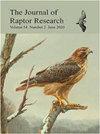智利中部安第斯秃鹰对垃圾填埋场的利用
IF 1.2
4区 生物学
Q2 ORNITHOLOGY
引用次数: 0
摘要
我们在此描述安第斯秃鹰(Vultur gryphus)将智利最大的垃圾填埋场作为食物来源的情况。我们在 2005 年至 2022 年期间对垃圾填埋场进行了监测。直到 2013 年,垃圾填埋场中的秃鹰数量一直在增加。随后,由于受到极端干旱的影响,牛的死亡率很高,而且由于爆发了蕈蚊病,兔子的尸体很多,因此在大范围内,食物供应充足。在两性和各年龄段都观察到了相同的时间和数量趋势。与已公布的种群参数相比,垃圾填埋场中未成年雄性的比例较高,成年雄性的比例较低;因此,垃圾填埋场可能主要对该物种优势等级中的下层起到补贴作用。秃鹫的活动有很强的季节性,暖季秃鹫数量较少,而寒季秃鹫数量最多,这可能与牲畜在高山夏季和冬季牧场之间的季节性迁移有关,导致秃鹫在寒季的食物丰度较低。这是首次描述大量安第斯秃鹰使用垃圾填埋场的情况,这可能会对智利中部的秃鹰种群产生影响。尽管垃圾处理作为一种补贴具有明显的积极作用,但由于秃鹰消耗潜在的危险化合物,垃圾处理可能会产生有害影响。这项研究强调了安第斯秃鹰的机会主义性质,它是一种可以利用垃圾堆的物种。在垃圾填埋场对安第斯秃鹰进行长期监测,可作为大范围内食物供应的指标,在保护战略中应加以考虑。本文章由计算机程序翻译,如有差异,请以英文原文为准。
Landfill Use by Andean Condors in Central Chile
We here describe Andean Condors' (Vultur gryphus) use of the biggest landfill in Chile as a food source. We monitored the landfill between 2005 and 2022. Until 2013, there was an increase in the number of condors present in the landfill. Then the number decreased until 2016, coincident with an abundant food supply on a large spatial scale, due to high mortality of cattle that were affected by extreme drought and plentiful rabbit carcasses due to outbreaks of myxomatosis. The same temporal and numerical trends were observed in both sexes and all ages. Compared to published population parameters, in the landfill the proportion of immatures was higher and that of adult males was lower; therefore, the landfill could function as a subsidy mainly for the lower strata of the dominance hierarchy of this species. There was a strong seasonality, with a low presence of condors in the warm season and maximum numbers in the cold season, likely coinciding with seasonal movements of livestock between summer and winter range lands in the high mountains, resulting in lower food abundance for condors during the cold season. This is the first characterization of the use of a landfill by a high number of Andean Condors, use that could have implications for the species' population in central Chile. Despite the apparent positive effect as a subsidy, waste disposals can have detrimental effects due to condors' consumption of potentially dangerous compounds. This study underscores the opportunistic nature of the Andean Condor, a species that can take advantage of rubbish dumps. Long-term Andean Condor monitoring at landfills may serve as an indicator food supply over a large spatial scale, which should be considered in conservation strategies.
求助全文
通过发布文献求助,成功后即可免费获取论文全文。
去求助
来源期刊

Journal of Raptor Research
生物-鸟类学
CiteScore
2.30
自引率
17.60%
发文量
61
审稿时长
>12 weeks
期刊介绍:
The Journal of Raptor Research (JRR) is an international scientific journal dedicated entirely to the dissemination of information about birds of prey. Established in 1967, JRR has published peer-reviewed research on raptor ecology, behavior, life history, conservation, and techniques. JRR is available quarterly to members in electronic and paper format.
 求助内容:
求助内容: 应助结果提醒方式:
应助结果提醒方式:


